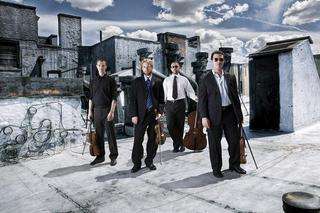|
Back
Guilts and Dedications New York
Le Poisson Rouge, 162 Bleecker Street
06/29/2010 -
Earle Brown: Tracking Pierrot
Caleb Burhans: Contritus
Jason Eckhardt: 16
Yoshiaki Onishi: Culs-de-sac (en passacaille)
International Contemporary Ensemble (ICE): Claire Chas (Flute), Joshua Rubin (Clarinet), Jacob Greenberg (Piano), Jennifer Curtis, Eric Carlson (Violins), Wendy Richman (Viola), Kivie Cahn-Lipman (Cello), Nathan Davis (Percussion) – JACK Quartet: Christopher Otto, Art Streisfeld (Violins), John Pickford Richards (Viola), Kevin McFarland (Cello)

JACK Quartet (© Le Poisson Rouge)
The title of last night’s wonderful concert at Le Poisson Rouge sounded like a cocktail: “ICE + JACK”, though, actually are the names of two extraordinary young ensembles. ICE is the International Contemporary Ensemble, which the New Yorker called “brilliant and unexpected.” “JACK” is an acronym from the artists’ first names, with equal accolades for their programming.
The subtitle: “Darmstadt Send-off Concert” was not quite true. Yes, both groups are going to Darmstadt, that Mecca of all things contemporary ever since Boulez, Stockhausen and the crème of “new music” of the 1950’s founded it some 50 years ago. But this was the penultimate concert, since they give another recital at the Gramercy Park Hotel tonight. After that, the twin ensembles are off to Germany and a series of concerts.
Both ICE and JACK are obvious siblings. They are both young, their prowess–especially in new sounds and new techniques–is unexcelled, and their affinity with Darmstadt iconoclasm is evident. Four different styles were exhibited here, but they all showed, if not perfect success, the aim of breaking barriers.
True, one “old” work was played, Earle Brown’s now classic Tracking Pierrot, played by members of ICE. Because of its nominal homage to Schoenberg (though dedicated to Messiaen and Morton Feldman: Brown covered all bases!) this is a Darmstadt avatar. But “nominal” means more than titular. The instruments were close to Schoenberg’s own–flute, clarinet, piano violin, cello, and vibraphone. Schoenberg used piccolo with flute, but Mr. Brown went down to the bottom, and clarinetist Joshua Rubin took out his huge bass clarinet for some haunting sounds.
Like Pierrot Lunaire, it was divided into several sections, and the canonic playing was easy to hear, while the orchestral patina was akin to Arnold’s original. But this was a visual work as well, since it called for a conductor. Brown used to conduct the ensembles on his own. But here, each played had a chance to conduct, using–what seemed to be–baseball signals along with their hands. Instead, they were giving numbers, but this was not a signal to improvise. Brown had written every note, but this was one of his “mobile” works, where the progression was up to the players. In other words, Tracking Pierrot, like jazz, will never be repeated in the same way again.
The second work, Contritus, written last year and placed by the JACK Quartet, was easily the most accessible music, though the reason wasn’t quite what Caleb Burnhans may have wished. In presenting a trio of prayers of contrition from the Catholic Church, Mr. Burnhans presented a kind of archaic (close to Dufay) series of viol harmonies.
They were beautiful and antique, and the three slow movements were extremely affecting. They also sounded far far too much like Arvo Pärt’s religious music. The repetitions, the antique modes, the solemnity breathed music of the Estonian. But Mr. Burhans added some extremely beautiful harp sounds that I have heard nowhere else. Certainly, this music was more memorable in the mind than any other works.
Jason Eckhardt’s 16 was blatantly–if not musically–a piece of political protest. The title refers to the 16 words which President Bush did not omit from his speech about Iraq (about getting nuclear material from Africa). The composer rightly mentions the “deceit” of this false claim. The music does not (so far as I could hear) have any relations to “16 words” (though perhaps some themes were 16 measures long). Instead, it was an agonizing, jittery, nervous soundscape (flutist Clair Chase made more breathing exercises than actual tones), with some fierce crescendos.
The final work was puzzling but not unlikeable. Yoshiaki Onishi’s Culs-de-sac in passacaglia mode, was written for JACK Quartet, and perhaps only the JACK could have handled the incredibly interesting sounds which came from their instruments. I am not a string player, so couldn’t begin to explain the sounds of rubbing against the fingerboard, the lack of vibrato, the pizzicato sounds, the never-ending rumbling and buzzing. At times, a shriek or beginnings of melody could be heard, but this was relegated down to the cellar of maggots, beetles and the innermost caverns of a hornet-nest.
I won’t ever figure it out, but I loved it. And methinks Darmstadt should find both groups as intriguing and inventive as the enthusiastic Poisson Rouge audience tonight.
Harry Rolnick
|